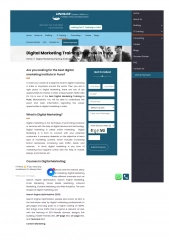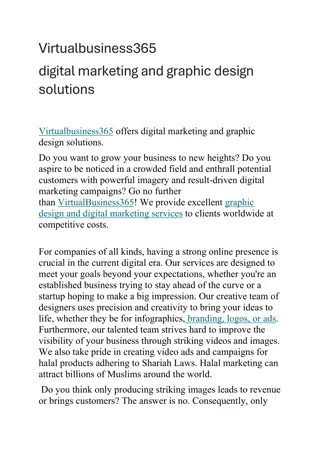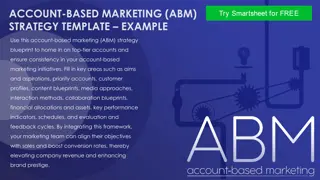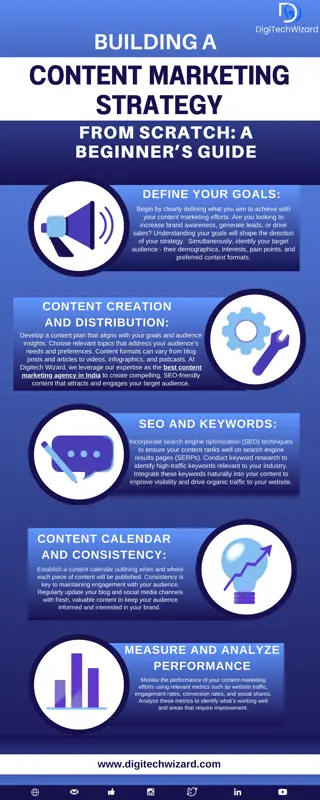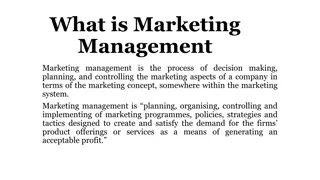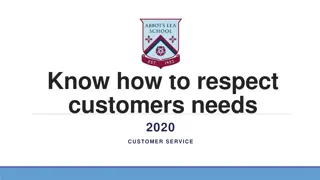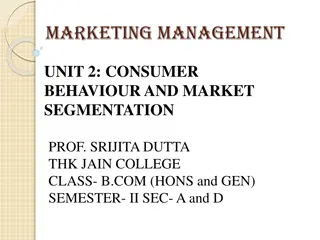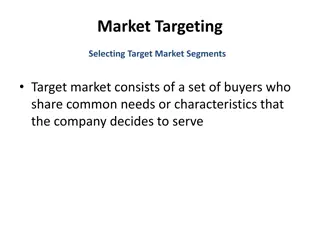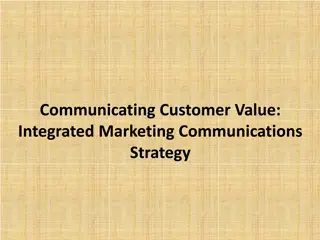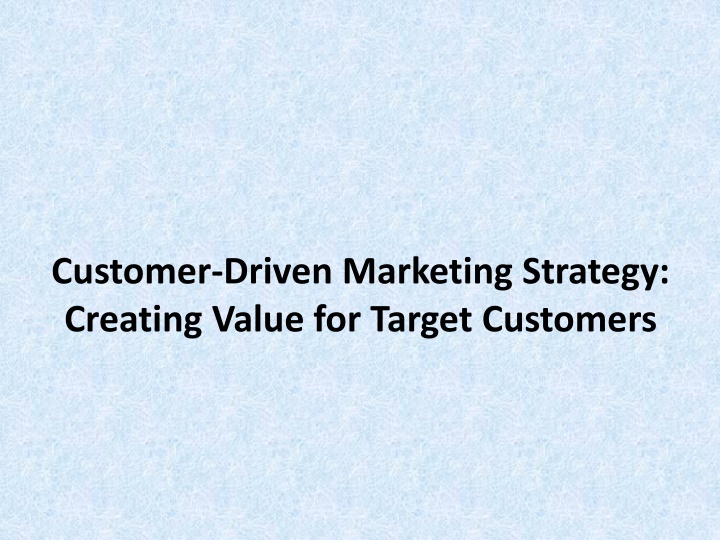
Crafting Customer-Driven Marketing Strategies for Value Creation
Explore the essence of Customer-Driven Marketing Strategy, focusing on differentiation, segmentation, targeting, and positioning to cater to the unique needs of target customers effectively. Learn about market segmentation, major bases, and variables essential for designing a successful marketing strategy.
Download Presentation

Please find below an Image/Link to download the presentation.
The content on the website is provided AS IS for your information and personal use only. It may not be sold, licensed, or shared on other websites without obtaining consent from the author. If you encounter any issues during the download, it is possible that the publisher has removed the file from their server.
You are allowed to download the files provided on this website for personal or commercial use, subject to the condition that they are used lawfully. All files are the property of their respective owners.
The content on the website is provided AS IS for your information and personal use only. It may not be sold, licensed, or shared on other websites without obtaining consent from the author.
E N D
Presentation Transcript
Customer-Driven Marketing Strategy: Creating Value for Target Customers
Session Outline Differentiation and Positioning Market Segmentation Market Targeting Customer-Driven Marketing Strategy
Customer-Driven Marketing Strategy Companies can not appeal to all buyers in the marketplace, or at least not to all buyers in the same way.
Designing a Customer-Driven Marketing Strategy Select customers to serve Decide on a value proposition Segmentation Differentiation Create value for targeted customers Targeting Positioning
Market Segmentation Dividing a market into smaller groups with distinct needs, characteristics, or behaviours that might require separate marketing strategies or mixes.
Segmentation (Cont.) Through market segmentation, companies divide large heterogeneous markets into smaller segments that can be reached more efficiently and effectively with products and services that match their unique needs
Segmenting Consumer Markets There is no single way to segment a market. A marketer has to try different segmentation variables, alone and in combination, to find the best way to view the market structure.
Major Segmentation Bases Geographic Demographic Psychographic Behavioural
Major Segmentation Variables Geographic Demographic Psychographic Behavioural World region or country Age Social class Occasions Country region Gender Lifestyle Benefits Province Family size Personality User status District Family life cycle User rates City Income Loyalty status Density Occupation Readiness stage Climate Education Attitude toward product Religion Nationality
Requirements for Effective Segmentation The size, purchasing power, and profiles of the segments can be measured. Measurable The market segments can be effectively reached and served. Accessible The market segments are large or profitable enough to serve. Substantial The segments are conceptually distinguishable and respond differently to different marketing mix elements and programmes. Differentiable Effective programmes can be designed for attracting and serving the segments. Actionable
Market Targeting Market Targeting The process of evaluating each market segment s attractiveness and selecting one or more segments to enter. Target Market A set of buyers sharing common needs or characteristics that the company decides to serve.
Targeting (Cont.) The firm now has to evaluate the various segments and decide how many and which segments it can serve best.
Evaluating Market Segments 1. Segment Size and Growth Sales, growth rates, expected profitability 2. Segment Structural Attractiveness Competitors, substitute products, power of buyers, power of suppliers 3. Company Objectives and Resources Long-run objectives, skills, resources
Selecting Target Market Segments Market Targeting Strategies Micromarketin g (local or individual marketing) Undifferentia ted (mass) marketing Differentiated (segmented) marketing Concentrated (niche) marketing Targeting broadly Targeting narrowly
Undifferentiated (Mass) Marketing A market coverage strategy in which a firm might decide to ignore market segment differences and go after the whole market with one offer. Mass marketing strategy focuses on what is common in the needs of consumers rather than on what is different.
Differentiated (Segmented) Marketing A market-coverage startegy in which a firm decides to target several market segments and designs separate offers for each. Results Higher sales, a stronger position within each market segment. Increasing the cost of doing businesses.
Concentrated (Niche) Marketing A market-coverage strategy in which a firm goes after a large share of one or a few smaller segments or niches.
Niche Marketing, Achieves a strong market position because of its greater knowledge of consumer needs in the niches it serves and the special reputation it acquires. Fine-tuning the marketing mix to the needs of carefully defined segments. Targeting communications programmes toward only consumers that it can serve best and most profitably. products or services, channels and
Micromarketing (Local or Individual) The practice of tailoring products and marketing programmes to the needs and wants of specific individuals and local customer groups. Micromarketing Local Marketing Individual Marketing
Local Marketing Tailoring brands and promotions to the needs and wants of local customer neighbourhoods, and even specific stores. groups cities, Individual Marketing Tailoring products and marketing programmes to the needs and preferences of individual customers also labeled one-to-one marketing , marketing , and markets-of-one marketing customized
Differentiation and Positioning Beyond deciding which segments of the market it will target, the company must decide on a value proposition on how it will create differentiated value for targeted segments and what positions it wants to occupy in those segments.
Product Position The way the product is defined by consumers on important attributes the place the product occupies in consumers mind relative to competing products.
Products are created in the factory, but brands are created in the mind.
Positioning Maps Perceptual Positioning Map Shows consumer perceptions of their brands versus competing products on important buying dimensions.
Choosing a Differentiation and Positioning Strategy A brand s positioning must serve the needs and preferences of well-defined target markets. 1. Identifying Possible Value Differences and Competitive Advantages Competitive Advantage An advantage over competitors gained by offering greater customer value, either through lower prices or by providing more benefits that justify higher prices.
In what specific ways can a company differentiate itself or its market offer? Product Differentiation Services Differentiation Channels Differentiation People Differentiation Image Differentiation
2. Choosing the Right Competitive Advantages How Many Differences to Promote - Unique Selling Proposition or - More than one differentiator Which Differences to Promote Each difference has the potential to create company costs as well as customer benefits.
A difference is worth establishing to the extent that it satisfies the following criteria: Important Distinctive Superior Communicable Preemptive Affordable Profitable
3. Selecting an Overall Positioning Strategy Value Proposition The full positioning of a brand - the full mix of benefits upon which the brand is differentiated and positioned. Why should I buy your brand?
Possible Value Propositions Winning value propositions Price More The same Less More for more More for the same More for less More Benefits The same for less The same Less for much less Less Losers
4. Developing a Positioning Statement A statement that summarizes company or brand positioning it takes this form: To (target segment and need) our (brand) is (concept) that (point-of- difference). Example To busy, mobile professionals who need to always be in the loop, BlackBerry is a wireless connectivity solution that gives you an easier, more reliable way to stay connected to data, people and resources while on the go.
Communicating and Delivering the Chosen Position Once it has chosen a position, the company must take strong steps to deliver and communicate the desired position to target consumers. All the company s marketing mix efforts must support the positioning strategy.




